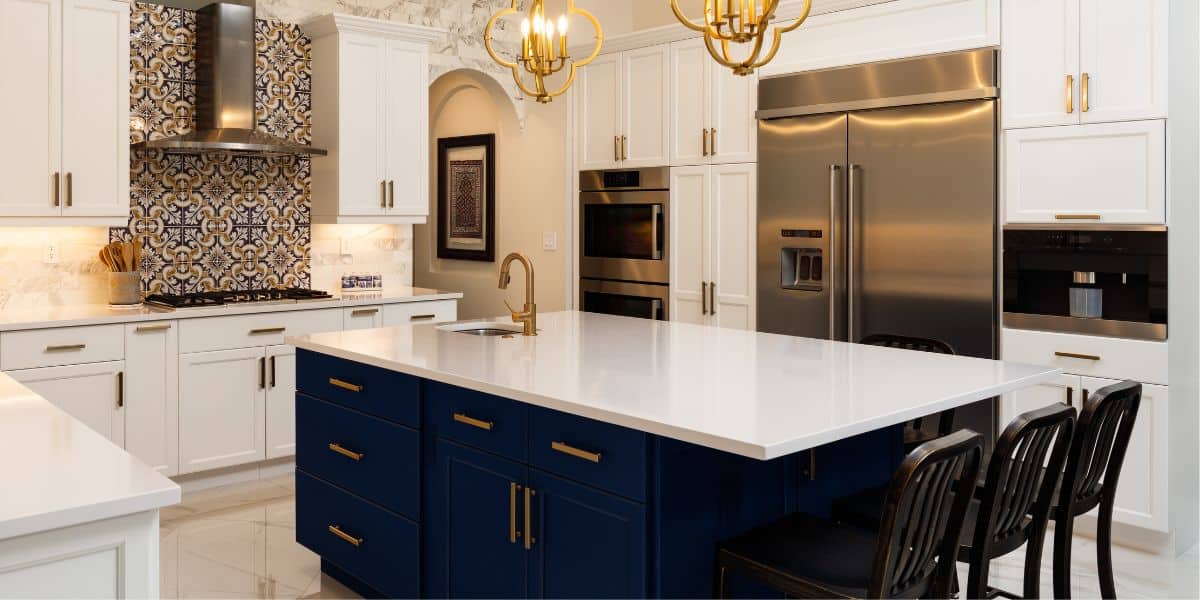In the 1950s, kitchen islands became popular. The kitchen island is a freestanding space with appliances and storage that can be found in many homes.
A large kitchen island is featured in almost every kitchen remodel you see on TV. There is a reason for this.
A kitchen island is a great way to combine form and function. It also creates a focal point in the room. It doesn’t necessarily mean that every kitchen should have one. Installing one has its pros and cons.
We will discuss the pros and cons of installing an island into your kitchen. You can then decide whether an island in your kitchen is the best use of space.
The Pros of a Kitchen Island
Installing an island in your home can have many benefits, including increased storage and workspace. Here are a few of them.
Storage Options Enhanced
Lack of storage is one of the biggest mistake made during a kitchen remodel. A kitchen island is a great solution for those who lack space in their kitchens, collect cookbooks and kitchen gadgets or love spices. It can provide additional drawers, cabinets and shelves.
A kitchen designer can help you design an island that is tailored to your needs. You can work with them to design storage solutions that are perfect for how you plan on using your island.
The kitchen island can also keep your utensils in order and at hand without taking up any space on your kitchen counters. The prep surface can be topped with a pantry.
It is a great way to have ingredients you use frequently close by and not hidden in cabinets.

Additional Work Surface
There is never enough counter space for a cook. A large, open area makes it easier to prepare meals and makes the cook happier.
A kitchen island provides ample counter space, allowing multiple chefs to work at the same time. This makes it a great option for anyone who enjoys cooking with their partner, has children that love to help, or hosts holidays in your home.
Seating Increased and Social Interaction
A kitchen island can be the ideal place to enjoy a quick meal.
It could be a quick bowl of cereal for breakfast or a sandwich to eat at lunch. A quick snack on an island is easy.
If you like to entertain while you cook, a kitchen island is a great option.
You can cook delicious meals while conversing with your guests at the kitchen island. This is the perfect way to enjoy a cocktail or glass of wine with your guests, without having to feel separated. Your new kiitchen island with seating will become the hangout spot in your home that everyone will gravitate to at your next gathering.
The versatility of functionality
Multitasking is something we can all do. If you’re a multitasker, then you might love the kitchen island.
A kitchen island is a versatile piece of furniture that can be used for many purposes, including a breakfast bar, cooking station or home office.
The kitchen is a central part of the home. An island can enhance this. The island can serve as a place to do homework and eat a snack in the afternoon or a hub for snacking during a movie.
Focal Point
If you look at a kitchen featured in an interior design publication or on your favorite HGTV program, it always has one thing in common: a stunning focal point.
Another benefit of kitchen islands is that they create a focal point. A kitchen designer can help you achieve the look that will draw attention to your style.
Islands are a great way to bring in design elements from different rooms of your house to your kitchen.
You may, for example, want to choose a base color that you have used in another room. It will allow you to maintain a consistent aesthetic in your entire home. Don’t forget to accessorize your kitchen after your remodel.
It’s Good for Resale Price
Design and functionality of kitchen islands will never go out-of-style.
It allows you to place additional appliances on the island, such as sinks, wine refrigerators and ovens. This frees up counter space and more cabinets in your kitchen.
When potential buyers are viewing homes, a kitchen island is highly desired. It provides additional workspace, extra seating and storage for people who enjoy cooking at home and entertaining.

Cons of having a Kitchen Island
After reading all of the pros, you might wonder if a kitchen island has any cons. There are some considerations you should make before installing a kitchen island. They may not be cons in the traditional sense, but they do exist. Here are a few.
Cost considerations
The beautiful islands that you see on TV and in magazines are not cheap.
Cost should be at the top of the list when deciding whether or not a kitchen island will work for you. Materials, features, and installation costs can add up quickly.
You can expect to spend between $3,000 and $12,000 on an island for your kitchen. If you plan to install a sink, stovetop or oven on your island, it can add substantial cost to your kitchen remodel.
If you want more than a simple freestanding island, it may cost a lot.
Cleaning and Maintenance Challenges
Cleaning becomes more difficult as the area grows. The same applies to kitchen islands.
To keep the island looking good, it will be necessary to clean it more frequently. It’s the same for any storage space built into an island. If you do not regularly organize them, they can become cluttered.
Keep in mind that the island is a major focal point of the room. It’s important to keep it clean to prevent it from becoming an eyesore. How to clean your kitchen island also depends on what materials were used for the kitchen remodel. It is essential to use the correct materials to properly clean everything and not cause any harm to the materials..
Space Constraints and Incompatibility With Kitchen Layout
Some kitchen designs are not suited to an island, and forcing one in can have negative effects on the design.
An island may also disrupt the flow of the kitchen. The extra counter space or storage is not worth it if the kitchen is cramped and difficult to maneuver.
To work comfortably and safely, it is best to leave a space of at least 42 inches between the perimeter counter and the island. It is important to consider this.
An island is not the best option if you have a layout that is irregularly shaped or if your space is limited.
It is difficult to connect electricity, plumbing and venting
It is difficult to add plumbing, electrical, and ventilation to an island kitchen space.
To extend plumbing and electrical pipes from your main wall, you may need to tear up the flooring and replace it with new flooring.
It can be done by electricians, plumbing professionals, or flooring installers. HVAC technicians can install downdrafts, or hoods that are traditional over the island.
If you add these features to your island, be prepared to see both your budget and timeframe suffer.
Conclusion
Since the 1950s, kitchen islands have become a popular feature in many homes. They are a great focal point and provide extra storage, counter space, as well as a beautiful focal.
Before you invest in a custom-made kitchen island, it’s important to weigh all of the pros and cons.
